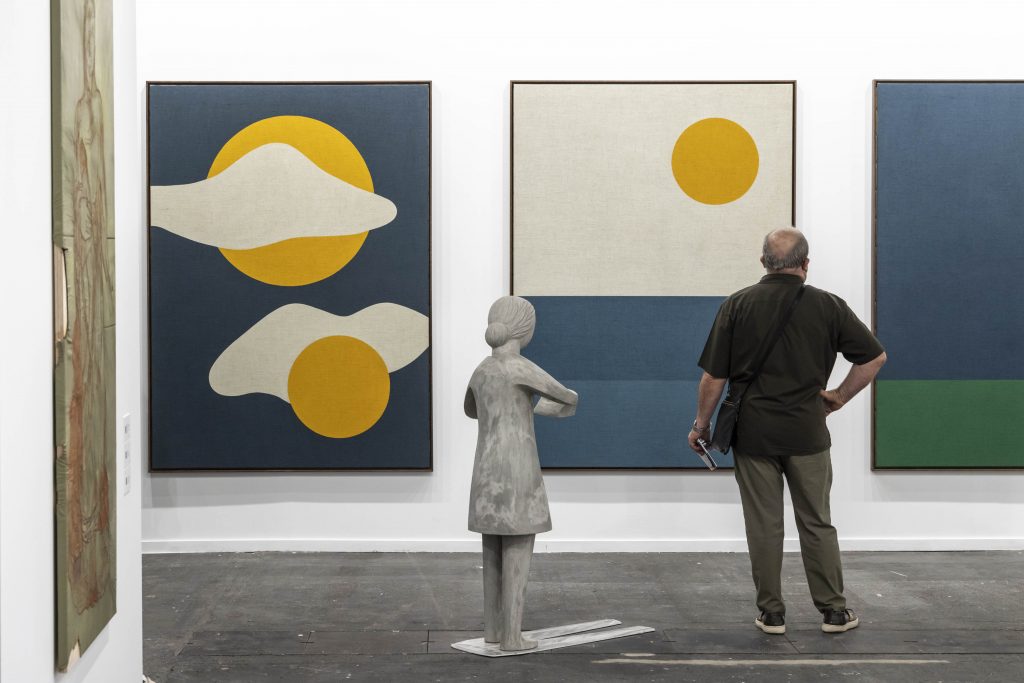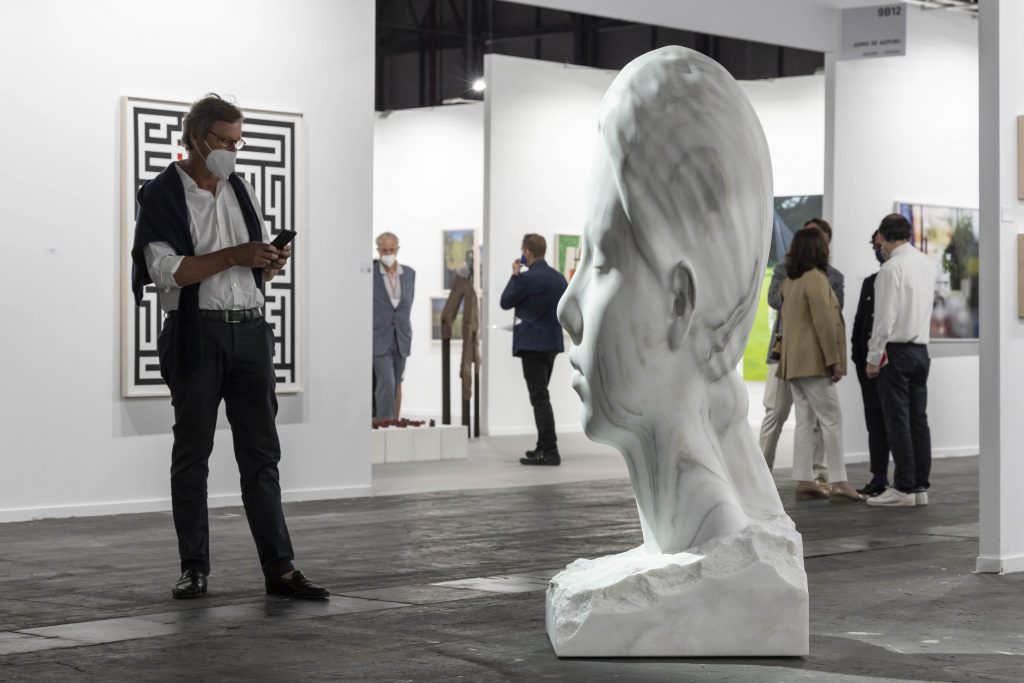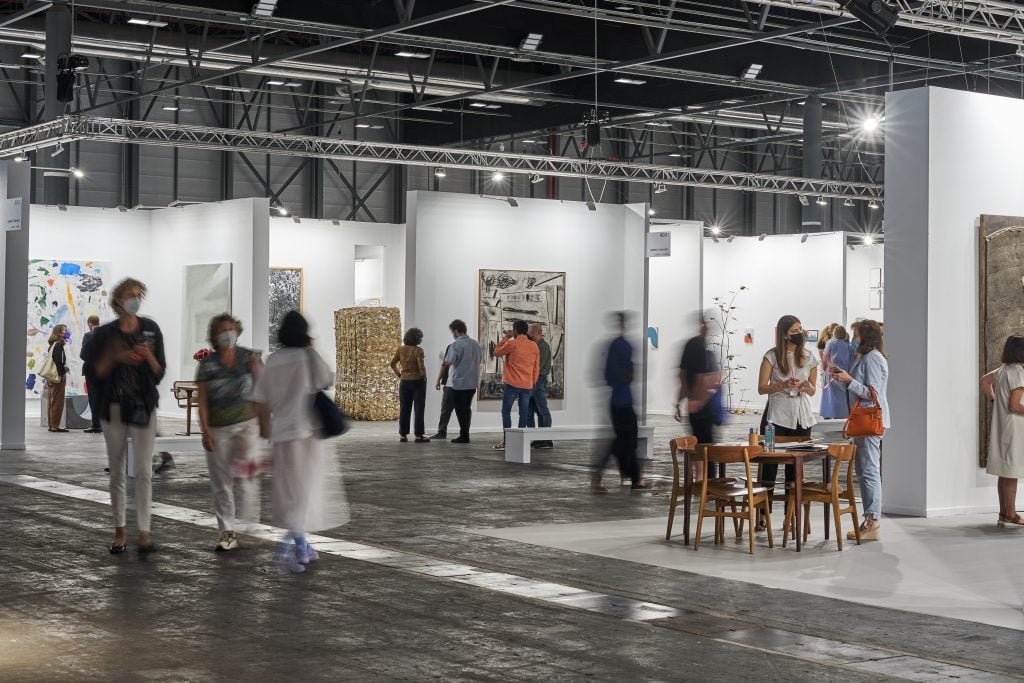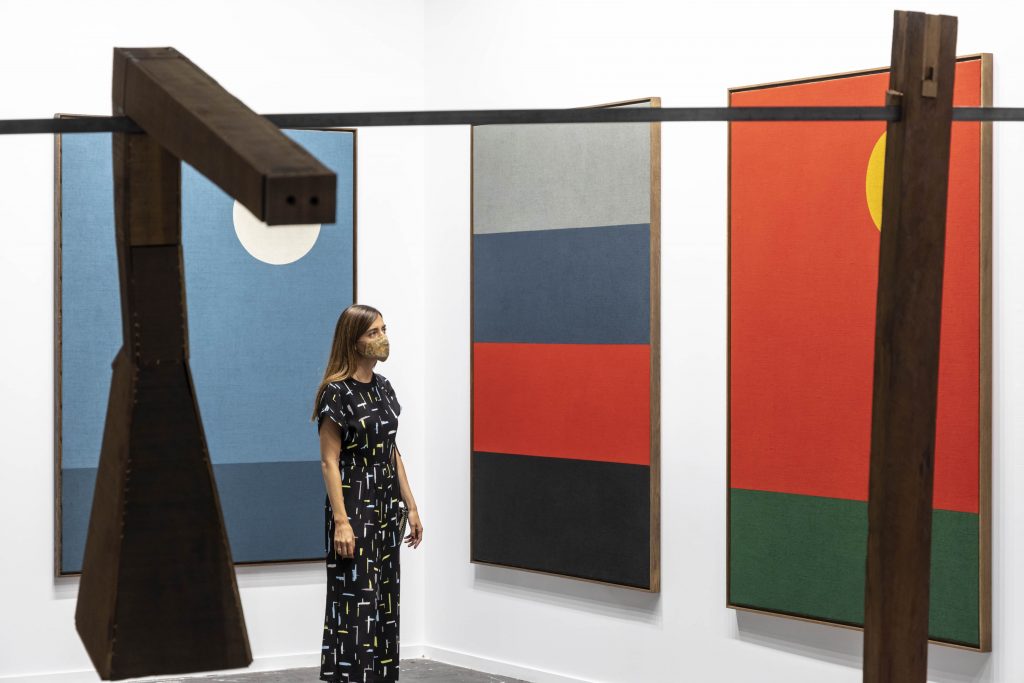Artnet News Pro
Arco Madrid Created a Market Moment for Spanish Art—But the Pandemic Kept International Galleries and Visitors Away
Sales edged forward on day one of the 40th edition of the Spanish art fair.

Sales edged forward on day one of the 40th edition of the Spanish art fair.

Arco Madrid reopened its doors to the world on Wednesday, five months later than planned but with considerable pent-up enthusiasm from gallerists and collectors alike.
The world’s largest Spanish-speaking art fair unveiled a compact, eclectic edition on opening day, with a maximum capacity set at 8,000—half the normal amount. Sales began cautiously and slowly, edging forward over the course of the day. With no proof of vaccination or negative COVID test required to enter, masks and temperature checks were mandatory as many attended their first international art fair in more than a year.
“The last fair we did abroad was Arco last year, so we hope this is the beginning of a new, positive moment for art fairs abroad, even if we still have to be cautious,” said Galerie Lelong’s Patrice Cotensin, a 35-year veteran of the fair.
To be sure, dealers did not experience the kind of gangbusters dash that some auctions have seen in recent months—but they seemed genuinely pleased with the level of engagement in a region not known for expensive impulse purchases. By early afternoon, Cotensin said, Martina’s World, a marble head sculpture by Jaume Plensa listed at €400,000 ($473,000) was on reserve, and there was “strong interest” in works by David Nash.

ARCO Madrid 2021.
Maribel López, Arco Madrid’s director, fought hard to get galleries to travel and delayed the 2021 event until the summer with hopes that case numbers would drop with warmer temperatures. “It is certainly smaller, 130 galleries… but we wanted to protect our international presence and we did—more than 50 percent of the galleries are international,” she said. Nevertheless, López decided to postpone Arco’s official 40th anniversary until next year, calling it “40+1”.
“It’s not good to have a party if your best friends cannot come,” she explained.
Thomas Krinzinger of Vienna’s Galerie Krinzinger reveled in the throngs flocking to his stand, and said there was “not a big difference to last year in terms of the crowd.” While travel restrictions allowed him to reconnect with domestic curators and collectors, he said, “the best thing is to be back in real life with real art.”
Krinzinger sold several pieces on opening day, including Sculpture La Gomera (€25,000 / $30,000) by Lois Weinberger, who died last year. The work is a photographic commentary on humanity’s literal and metaphorical footprint, featuring a collection of abandoned sandals arranged onto a tree, like fruit.
Most gallerists were keeping tight-lipped as works edged towards final sales, but sculptures by Antony Gormley at Thaddaeus Ropac and Eduardo Chillida at Cayón were much discussed among visitors, as was 2a blanca (Gran escultura blanca nº2), by Jesús R. Soto, believed to be the fair’s most expensive piece, at €1.3 million ($1.5 million). Ropac ended up selling three Antony Gormley sculptures for £400,000 ($551,000) apiece, and also parted with a Daniel Richter painting for €200,000 ($237,000), and work by Gilbert & George (£70,000/$96,000), Martha Jungwirth (€65,000/$77,000) and Tony Cragg (€275,000/$326,000). At Marlborough’s stand, a reserve on Juan Genovés’s painting Valdepeñas for €215,000 ($254,000) fell through, but the gallery did sell a work by Abraham Lacalle listed at €4,000 ($4,700) and a sculpture by Blanca Muñoz.

ARCO Madrid 2021.
For those looking for Spanish art, the standout piece this year might be Guernica—but not that one. Madrid’s José de la Mano gallery unveiled a version of Agustín Ibarrola’s gigantic reimagining of Picasso’s masterpiece, standing two meters high and 10 meters long and painted in 1977. It was only recently rediscovered by the eponymous gallery owner, who saw it listed by chance in an old catalogue; it arrived in Madrid on the 40th anniversary of the arrival of Picasso’s own Guernica. It is only available to institutional buyers; there have been no takers yet.
Many Spanish collectors said the pandemic helped lure them back to Spanish art after spending years buying from abroad. Eulogio Sánchez, who was given an award by Arco this year for his collection, said he “acquired almost exclusively international works for many years,” including examples by Kara Walker, Albert Oehlen, Raymond Pettibon, Alex Katz, and Miriam Cahn. He cited galleries such as Chantal Crousel, Juan Silió, Maisterravalbuena, Juana de Aizpuru, and Bruno Murias as rekindling his interest in art produced in Spain. The collector bought work by Spanish artist Nora Aurrekoetxea, as well as pieces by Silvia Bächli, and Jean-Luc Moulène.
Up-and-coming Madrid galleries such as Sabrina Amrani embody the new spirit from dual national artists who have roots in Spain but an eye on wider global trends. Argentine-Spaniard Gabriela Bettini’s stylized painting of the Amazon with a section cut out and covered with brown paper—a commentary on deforestation and appropriation—stood out, as did the tingling beauty of Korean-Spanish Jong Oh’s minimalist sculptures.

ARCO Madrid 2021.
Arco also continued its longstanding commitment to Latin American art and galleries, even when they couldn’t make it in person due to travel restrictions. The “Remitente” section of the fair featured work from 14 galleries and 18 artists, including the Argentinians Fernanda Laguna and Laura Mema (Galería Nora Fisch), and Mexico’s Juan Sebastián Bruno (Pasto).
“We realized that some of the galleries, even though they wanted to come, couldn’t, so we had to make a decision,” López said. “There are works that didn’t need the gallery or didn’t need to travel from Latin America because they are video pieces, because they were already in Spain, or because galleries support each other: a gallery from Paris brought a piece for a gallery from Brazil.”
One notable absence at Arco were British gallerists and curators—call it the Brexit effect. Pati Lara of the Ryder, one of few galleries this year with a presence in London, has switched her base permanently to Madrid.
By the end of opening day, Lara had sold a painting inspired by the best-selling works at global auction houses from the Swedish artist Jonas Lund for €12,500 ($15,000) and Andrea Galvani’s neon Doppler effect sculpture for €14,000 ($17,000).
“My original intention was to have two galleries open at the same time and to create a dialogue between the artist scenes in both countries,” she said. “Since Brexit, I have shipped about 25 works between one country and the other and it’s a nightmare at the border and it’s very expensive, so I decided I was going to keep the base in Madrid.” London’s loss is Spain’s gain.
Arco Madrid is open through July 11 at Ifema Madrid.